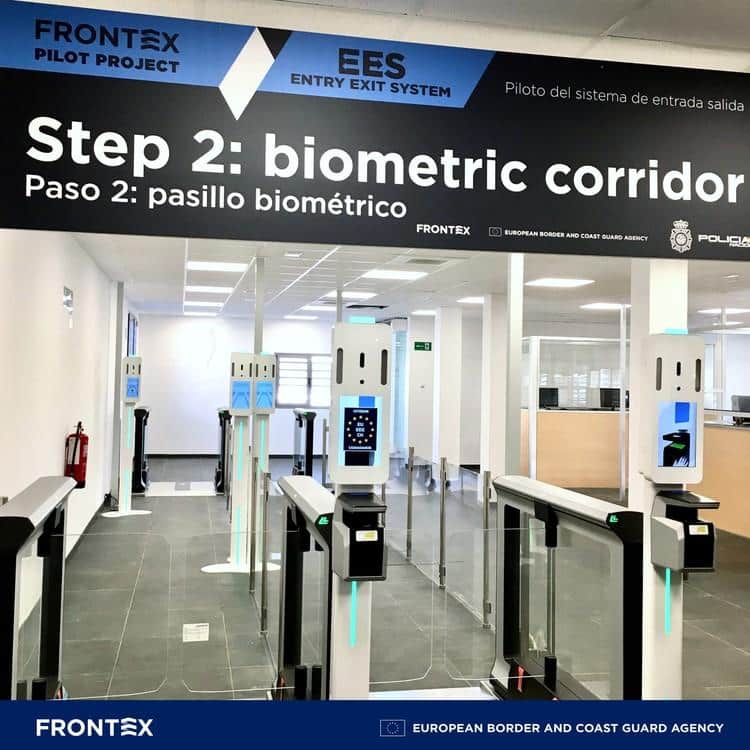In the intricate tapestry of international travel, where threads of security and freedom interweave against a backdrop of ever-evolving technological landscapes, Europe stands poised at the precipice of a new dawn. The European Entry/Exit System (EES) promises to revolutionize the way travelers enter and exit the tapestry’s vibrant hues, intending to streamline processes with a digital overhaul aimed at enhancing security and border management. Yet, as the horizon teems with the glow of innovation, clouds of uncertainty gather, casting long shadows over the eagerly anticipated launch date. Could it be that the unveiling of this modern marvel faces another delay, threading more suspense into the complex weave of border control narratives? As we stand on the brink of what could be a major shift in the realm of international mobility within Europe, questions flutter like leaves caught in a gust of wind, signaling the potential for another pause in the grand unveiling of the EES. Join us as we unravel the layers of this unfolding story, exploring the intricacies behind the possible postponement of Europe’s new border system, a narrative rich with the promise of progression yet tempered by the caution of meticulous implementation.
Navigating Uncertainties: The Path to Launching Europe’s New Border System
With the introduction of the European Entry/Exit System (EES), aimed at enhancing security measures and streamlining border checks within the Schengen Area, the stakes are undoubtedly high. The vision is grand – a Schengen zone fortified yet fluid, ensuring safety without sacrificing the cherished freedom of movement. However, the pathway to this new dawn is fraught with complex challenges and uncertainties. The ambitious project, initially slated for launch in early 2022, has seen delays that have sparked concerns and debates across member states. It’s a delicate dance of technology meets policy, where every step forward is carefully measured against possible setbacks and the imperative need to uphold privacy and personal freedoms.
The intricacies involved in rolling out such a comprehensive system cannot be overstated. From the technological backbone that needs to securely process vast amounts of data, to the political consensus required among member states, every aspect needs to be meticulously aligned. Consider the following critical hurdles that could potentially lead to further delays:
- Technical Readiness: Ensuring that the new system is robust and capable of handling the volume of data without compromising speed or security is paramount. This includes rigorous testing phases that may reveal unforeseen issues needing resolution.
- Compliance and Training: Border officials across participating countries need comprehensive training on the new system. Additionally, ensuring compliance with the EU’s strict data protection regulations (GDPR) adds another layer of complexity to the process.
- Political and Public Support: Achieving a consensus among member states, each with its own set of priorities and concerns, is a formidable challenge. Moreover, garnering public support amidst privacy concerns and potential operational hiccups during the initial phase is crucial for a smooth transition.
In light of these considerations, whether the EES can adhere to its revised launch timeline remains a question that only time will answer. As planning continues and potential roadblocks are addressed, the hope is that Europe can pave a way forward that balances security with the seamless movement that has long been a cornerstone of the Union’s ethos.
The Tangled Web of Technical and Regulatory Challenges
Delving deeper into the labyrinth of intricacies surrounding the impending rollout of Europe’s Entry/Exit System (EES), it’s evident that the initiative is ensnared in both technical and regulatory thickets. On the technical front, developers and IT specialists are grappling with massive data management challenges. They must ensure the seamless integration of biometric technologies, capable of accurately processing millions of identities without compromising the speed or security of border checks. Moreover, the system’s infrastructure must be robust enough to handle peak traffic volumes without faltering – a non-negotiable requirement in today’s digital age where both efficiency and security are paramount.
On the flip side, the regulatory hurdles are just as daunting. Member states are tasked with navigating a dense maze of national and European Union (EU) laws, often finding themselves at crossroads where compliance with one directive seems to contravene another. For instance, the stringent data protection laws in the EU, such as the General Data Protection Regulation (GDPR), add layers of complexity to EES’s operational blueprint. Legislators and policymakers are in a continuous dialogue, trying to strike a delicate balance between enhancing border security and preserving individual privacy rights. The table below encapsulates some of the key technical and regulatory challenges that could potentially derail the scheduled launch of the EES.
| Challenge Type | Key Issues |
|---|---|
| Technical | Data integration, Biometric processing, Infrastructure scalability |
| Regulatory | GDPR compliance, Interoperability with national laws, Security vs. Privacy balance |
A Strategic Roadmap: Ensuring Timely Implementation of the EES
To effectively navigate the complexities of introducing the European Entry/Exit System (EES), a comprehensive and carefully structured plan is crucial. This involves not only meticulous preparation and testing phases but also the establishment of clear milestones and contingency measures to address potential setbacks. The plan should embody a multi-layered approach that prioritizes:
- Stakeholder Engagement: Regular updates and collaborative sessions with all stakeholders, including border control agencies, airline operators, and EU member states, ensure aligned expectations and foster a cooperative environment for troubleshooting and feedback.
- Technology Integration and Testing: Rigorous and iterative testing of the EES infrastructure, with particular attention to biometric data processing and interoperability with existing national systems, is essential to verify readiness and functionality.
- Training and Support: Customized training programs for border control officials and support teams will facilitate a smooth transition, enhancing the user experience for both operational staff and travelers.
A phased rollout strategy significantly mitigates risks associated with full-scale implementation. Initial pilot phases can serve as valuable learning opportunities, allowing for adjustments and optimizations before wider application. This phased approach, combined with real-time monitoring and agile response mechanisms, ensures adaptability and resilience. The following table illustrates a simplified strategic timeline for the EES rollout, emphasizing critical milestones:
| Phase | Objective | Completion Target |
|---|---|---|
| Pilot Testing | Validate system functionality and interoperability in controlled environments. | Q3 2023 |
| Full-Scale Implementation | Deploy the EES across all EU external borders, ensuring operational efficiency and compliance. | Q2 2024 |
| Ongoing Optimization | Continuously enhance system capabilities and user experience based on feedback and emerging needs. | Q4 2024 and beyond |
Through a methodical and strategic roadmap, the European Union can significantly improve the likelihood of a timely and successful EES implementation, reinforcing the security and efficiency of its borders while adapting to unforeseen challenges along the way.
Beyond Deadlines: Recommendations for a Smoother Transition
As anticipation grows around the European Union’s Entry/Exit System (EES), the focus tends to sharpen on deadlines and the potential for delays. However, moving beyond the ticking clock, there are several steps that can be taken to ensure the transition to the EES is as seamless as possible. Firstly, stakeholders, including border control agencies, airlines, and travelers themselves, should be provided with comprehensive education and training on the new system. This includes familiarization with biometric data collection, which is at the heart of EES. Enhancing understanding and operational readiness can significantly mitigate the impact of any unforeseen delays.
Moreover, the implementation phase could benefit from a robust feedback mechanism. Constructive input from early adopters and pilot users of the system could inform necessary adjustments before a wider rollout. This iterative approach not only fosters a culture of continuous improvement but also helps in identifying and ironing out potential teething problems. Below is a simplified overview of recommended steps for a smoother EES transition:
| Step | Action |
|---|---|
| 1 | Educate all stakeholders on EES functionalities and requirements. |
| 2 | Implement comprehensive training programs for operators. |
| 3 | Conduct pilot tests and gather feedback. |
| 4 | Refine and adapt based on real-world input and challenges. |
Implementing these steps can create a conducive environment for the EES launch, reducing the likelihood of significant disruptions. This approach emphasizes preparing all involved parties for a future where crossing European borders is more secure but also more efficient and streamlined. The goal is to ensure that the launch of EES, when it happens, marks a positive progression towards modernized and effective border management across the EU.
To Conclude
As the sun sets on yet another day of debates and deliberations over the European Entry/Exit System (EES), the continent finds itself at a crossroads. Poised between the desire for enhanced security and the practical realities of implementation, the question looms large: Will the EES gateway open as scheduled, or will its debut be postponed once more? While the sands of time slip quietly through the hourglass, the stakeholders’ fervent efforts and discussions continue to shape the contours of Europe’s border future.
In this dance of deadlines and delays, the EES emerges not just as a system, but as a symbol of a Europe striving for balance; a balance between welcoming with open arms and safeguarding its citizens. It’s a testament to the continent’s ongoing quest to navigate the complexities of modern governance, where innovation intersects with the imperatives of security and freedom of movement.
As we await the final announcement, let us remember that the journey towards implementing such ambitious systems is seldom linear. It is peppered with challenges and learnings that ultimately contribute to a more secure, organized, and welcoming Europe. Whether the EES flings its doors wide open on the next promised date or takes a bow of delay, the narrative is far from over. It’s but a chapter in Europe’s enduring saga of evolution and adaptation in an ever-changing world.
And so, as the horizon of the EES’s fate remains shrouded in the mists of uncertainty, our gaze remains fixed on the unfolding story. A story not just of lines and borders, but of people, dreams, and the endless quest for a harmonious coexistence. Until the veil lifts, we watch, we wait, and we wonder, ready to pen the next chapter of the European journey, whenever it may begin.




